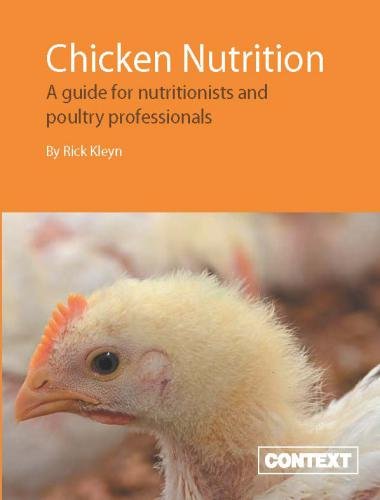Chicken Nutrition: A Guide for Nutritionists and Poultry Professionals
Author: Rick Kleyn in 2013
As a practising commercial poultry nutritionist I am often called upon to share my knowledge with others. The latter
 includes groups of poultry producers, fellow practitioners and university students. To this end I have been running a 3-day introductory course in poultry nutrition for over a decade, which has been attended by hundreds of people from many countries. This book began as study material for that course. The fast pace of change in the poultry industry has necessitated continuous revision and this volume represents the culmination of years of work. Those of us who work in the poultry industry will know that production systems and management practices have an impact on the way in which chickens should be fed, how production results should be interpreted and how any associated problems should be solved. Where relevant, aspects of production systems that are relevant to nutritional decision-making are discussed.
includes groups of poultry producers, fellow practitioners and university students. To this end I have been running a 3-day introductory course in poultry nutrition for over a decade, which has been attended by hundreds of people from many countries. This book began as study material for that course. The fast pace of change in the poultry industry has necessitated continuous revision and this volume represents the culmination of years of work. Those of us who work in the poultry industry will know that production systems and management practices have an impact on the way in which chickens should be fed, how production results should be interpreted and how any associated problems should be solved. Where relevant, aspects of production systems that are relevant to nutritional decision-making are discussed.
Feed makes up about 70% of the production cost of any poultry production system. While many poultry producers have an excellent understanding of poultry pathology few understand what it is that the nutritionist is trying to achieve. This is borne out by the comment of one of our course delegates, who thought, ‘amino acids were something that one put into the swimming pool’. He has assured me that he now knows better! It is vital that all poultry practitioners have at least a working knowledge of nutrition, even if it is only to keep feed suppliers on their toes.
To many people poultry nutrition appears to be more complex than the nutrition of other species. Scott (1991) makes the point that more is known about poultry nutrition than any other species, which is partly true because of the practical incentive to produce the most highly efficient chicken feeds. It is, however, also true because the chicken is one of the most suitable animals for studying basic nutrition. There is, therefore, a large knowledge base for poultry nutrition and, in many ways, this simplifies poultry nutrition rather than complicates it.
This book explores some of the underlying theory of poultry nutrition rather than providing a step-by-step methodology for formulating poultry diets. If the underlying principles are understood, it makes it easier to recognise what is seen in the field and to be equipped to solve any problems. Teaching nutrition is always a little difficult. It is a little akin to a bicycle wheel. Each spoke needs to be dealt with individually, and it is not until all of the spokes are in place that the wheel of our understanding is complete. Despite this shortcoming it is hoped that the book will serve as a useful resource for people involved in poultry production, feed manufacture and to students who are trying to grasp the intricacies of poultry nutrition.
| PDF Size: 1 MB | Book Download Free |
Password: pdflibrary.net
Password: pdflibrary.net

How it could be downloaded ??
Yes you may download it free from the given link.
I cant see the download link
What issue you r facing, download link working fine.